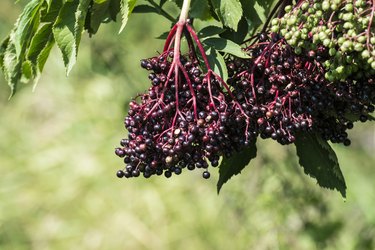
The elderberry bush (Sambucus spp.) is a fruit-bearing, multi-stemmed deciduous shrub native to eastern North America. Elderberries are perennials in U.S. Department of Agriculture hardiness zones 3 to 9, depending on species and cultivar. The plant grows clusters of round, purplish-black berries that are a hit with songbirds. You may turn up your nose at the unpleasant astringent taste of raw elderberries, but cooked elderberries can be made into tasty pies, jellies or wine.
Growth Habit
Video of the Day
Elderberry plants can grow into small trees more than 15 feet tall with a spread matching the height. Wild elderberry bushes grow from seeds, typically spread by birds, and the plants also form dense thickets by raising suckers from the shallow root systems.
Video of the Day
The plants grow feathery compound leaves up to a foot long with up to nine leaflets that grow on opposite sides of the leaf stem. The plants grow tiny star-shaped white flowers in spring and summer, forming beautiful clusters up to 10 inches across. Each flower in the cluster develops into a berry that's up to 1/4 inch in diameter.
Cultivars
Like most berries, elderberries come in different varieties. The one you choose depends largely on what you want to do with them. Try one of these options:
- Adams: Ideal for pie-making, this variety grows large, juicy berries with large dark clusters that look nice in your landscaping.
- Johns: If you have your eye on making jelly, try this variety. It produces lots of berries and can grow up to 12 feet, so make sure you have enough space.
- Black Beauty: This variety only gets about 6 to 8 feet tall, making it perfect for smaller spaces. It's also a good landscaping plant due to its purple leaves and pink flowers.
- Black Lace: This variety is similar to Black Beauty, with dark purple foliage and fruits plus pink flowers.
- Lemony Lace: This option works well for northern locations because it holds up against cold and wind. This hardy variety has light-colored leaves and reddish berries.
- York: This variety is also cold tolerant. It grows a high yield of large berries. In the fall, the leaves turn a bright red color.
Culture
Elderberries do best in full sun but can tolerate partial shade. They aren't fussy about soil pH and can grow in acidic or alkaline soils. Elderberries do best in moist, well-draining soil but can tolerate dry spells. Cultivated and wild varieties grow from seeds, transplanted suckers or cuttings.
Plant elderberries in the spring, spacing the plants 6 to 10 feet apart. Fertilize annually in the spring with a half-pound of 10-10-10 fertilizer for each year of the plant's age. If you grow elderberry bushes for the fruit, you need to plant at least two different cultivars within 60 feet of each other for good cross-pollination.
Pruning and Weeding
Elderberry bushes send up new canes each year. The canes are most fruitful in their second and third years. Prune the old canes away after the third year to make room for younger canes. Prune old, broken or dead canes in late winter or early spring while the plants are dormant. Elderberries are shallow-rooted, so you need to pluck weeds by hand or spread mulch around the plant to stop weeds from growing.
Pests and Diseases
Elderberries are resistant to most, but not all, pests and diseases. Birds are by far the worst pest, stripping berries as soon as they ripen. Covering bushes with netting is the most effective way to keep the birds from the berries.
Unexpected wilting and death of canes may mean you have an insect or disease problem. You can control insect pests and diseases by pruning and burning the infested and dead canes. Remove all wild elderberry plants within 100 feet of your cultivated elderberry patch for additional protection.
Preparing Elderberries
Elderberries ripen from late August through early September. Pick entire clusters of berries, and strip the berries from the stems. Place the berries in hot water, and let them simmer for 15 minutes to cook them. Use the cooked berries in pies, or place the cooked berries in a cheesecloth berry bag and squeeze out the juice.